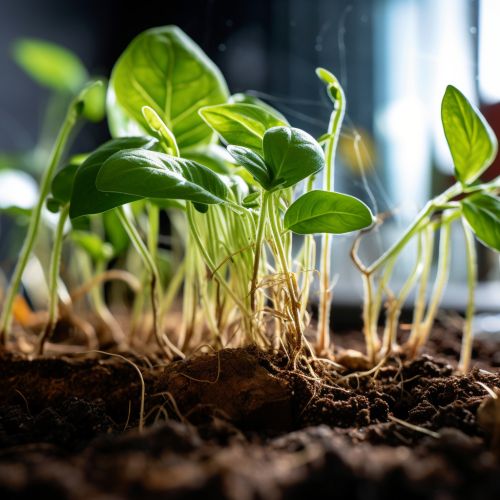Plant hormone
Introduction
Plant hormones, also known as phytohormones, are chemical substances that play a crucial role in regulating plant growth and development. They are synthesized naturally within the plant and are responsible for coordinating the growth and differentiation of cells, tissues, and organs. These hormones are involved in virtually every aspect of plant growth and development, from embryogenesis and seed germination to organogenesis and senescence.
Classification of Plant Hormones
Plant hormones can be classified into five major classes: auxins, gibberellins, cytokinins, abscisic acid (ABA), and ethylene. Each class of hormones has a unique structure and function, and they work in concert to regulate various aspects of plant growth and development.
Auxins
Auxins are a group of hormones that play a pivotal role in the coordination of many growth and behavioral processes in the plant's life cycle. They are primarily involved in cell elongation, apical dominance, and tissue differentiation. The most common naturally occurring auxin is Indole-3-acetic acid (IAA).
Gibberellins
Gibberellins are a large family of diterpenoid compounds that regulate a wide range of developmental processes, including stem elongation, germination, dormancy, flowering, sex expression, enzyme induction, and leaf and fruit senescence.
Cytokinins
Cytokinins are a class of plant growth substances that promote cell division, or cytokinesis, in plant roots and shoots. They are involved primarily in cell growth and differentiation, but also affect apical dominance, axillary bud growth, and leaf senescence.
Abscisic Acid
Abscisic Acid (ABA) is a plant hormone that regulates plant growth and development, particularly in response to stress conditions such as drought, cold, and salinity. It plays a central role in seed dormancy and germination, stomatal closure, and the modulation of plant architecture.
Ethylene
Ethylene is a gaseous plant hormone that regulates a wide range of biological processes in plants. It is involved in many processes related to growth and development, including fruit ripening, senescence, leaf abscission, and defense responses to pathogens.
Biosynthesis and Metabolism of Plant Hormones
The biosynthesis and metabolism of plant hormones are complex processes that involve multiple enzymatic reactions. These processes are regulated by a variety of factors, including environmental conditions, developmental stage, and the presence of other hormones.


Auxin Biosynthesis and Metabolism
The biosynthesis of auxins occurs in the shoot apical meristem and young leaves of plants. The primary precursor of auxin biosynthesis is the amino acid tryptophan. The metabolism of auxins involves conjugation and deconjugation reactions, which modulate the levels of active auxin in plant tissues.
Gibberellin Biosynthesis and Metabolism
Gibberellin biosynthesis takes place in young tissues of the shoot and developing seeds. The biosynthesis pathway involves the conversion of geranylgeranyl diphosphate to ent-kaurene, which is then converted to GA12, the precursor of all gibberellins. The metabolism of gibberellins involves deactivation reactions, which are crucial for maintaining the balance of active gibberellins in plant tissues.
Cytokinin Biosynthesis and Metabolism
Cytokinin biosynthesis occurs in various plant tissues, including roots, embryos, and fruits. The primary precursor of cytokinin biosynthesis is adenine, a purine base. The metabolism of cytokinins involves conjugation and deconjugation reactions, which regulate the levels of active cytokinins in plant tissues.
Abscisic Acid Biosynthesis and Metabolism
Abscisic acid biosynthesis occurs in plastids and the cytosol of plant cells. The primary precursor of ABA biosynthesis is carotenoids. The metabolism of ABA involves conjugation and deconjugation reactions, which modulate the levels of active ABA in plant tissues.
Ethylene Biosynthesis and Metabolism
Ethylene biosynthesis takes place in almost all parts of the plant, but especially in rapidly growing and aging tissues. The primary precursor of ethylene biosynthesis is the amino acid methionine. The metabolism of ethylene involves oxidation and reduction reactions, which regulate the levels of active ethylene in plant tissues.
Function of Plant Hormones
Plant hormones regulate a wide range of developmental processes in plants. They coordinate growth and development by controlling cellular processes at the molecular level.
Auxins
Auxins regulate cell elongation, apical dominance, and tissue differentiation. They are also involved in the formation of lateral and adventitious roots, the development of fruit, and the tropic responses of plants to light and gravity.
Gibberellins
Gibberellins regulate stem elongation, germination, and flowering. They also control the transition from juvenile to adult phases in plants, the sex expression of flowers, and the development of fruit.
Cytokinins
Cytokinins regulate cell division and differentiation, apical dominance, and leaf senescence. They also control the development of chloroplasts and delay the aging of leaves.
Abscisic Acid
Abscisic acid regulates seed dormancy and germination, stomatal closure, and the modulation of plant architecture. It also plays a crucial role in the plant's response to stress conditions such as drought, cold, and salinity.
Ethylene
Ethylene regulates fruit ripening, senescence, leaf abscission, and defense responses to pathogens. It also controls the opening and closing of flowers, the shedding of leaves, and the development of root nodules in leguminous plants.
Conclusion
Plant hormones play a crucial role in regulating plant growth and development. They coordinate the growth and differentiation of cells, tissues, and organs, and are involved in virtually every aspect of plant life. Understanding the biosynthesis, metabolism, and function of plant hormones is essential for improving crop yield and quality, and for developing new strategies for sustainable agriculture.
